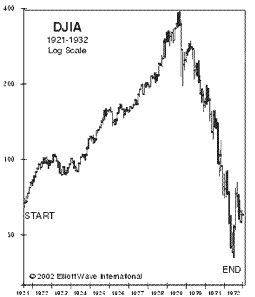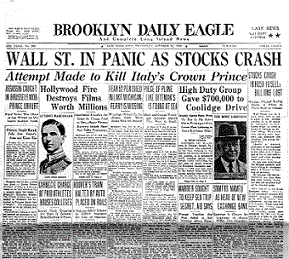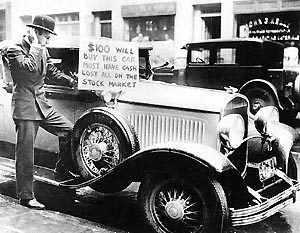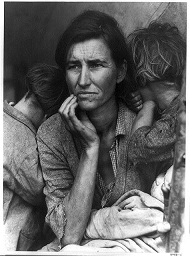By Jesse Colombo (This article was written on July 17th, 2012)
America’s Stock Market Crash of 1929 was a powerful market crash that started in October of 1929 after the Roaring Twenties economic “bubble boom” finally popped.
America experienced an era of great peace and prosperity during the 1920s. After World War I, the so-called “Roaring Twenties” economic and cultural boom was fueled by industrialization and the popularization of new technologies such as radio and the automobile. Air flight was becoming common as well.
 The Dow stock average soared throughout the Roaring Twenties and many investors aggressively purchased shares, comforted by the fact that stocks were thought to be extremely safe by most economists due to the country’s powerful economic boom. Investors soon purchased stocks on margin, which is the borrowing of stock for the purpose of gaining financial leverage. For every dollar invested, a margin user would borrow nine dollars worth of stock. The use of leverage meant that if a stock went up 1%, the investor would make 10%. Unfortunately, leverage also works the other way around and amplifies even minor losses. If a stock drops too much, a margin holder could lose all of their investment and possibly owe money to their broker as well.
The Dow stock average soared throughout the Roaring Twenties and many investors aggressively purchased shares, comforted by the fact that stocks were thought to be extremely safe by most economists due to the country’s powerful economic boom. Investors soon purchased stocks on margin, which is the borrowing of stock for the purpose of gaining financial leverage. For every dollar invested, a margin user would borrow nine dollars worth of stock. The use of leverage meant that if a stock went up 1%, the investor would make 10%. Unfortunately, leverage also works the other way around and amplifies even minor losses. If a stock drops too much, a margin holder could lose all of their investment and possibly owe money to their broker as well.
From 1921 to 1929, the Dow Jones rocketed from 60 to 400, creating many new millionaires. Very soon, stock trading became America’s favorite pastime as investors jockeyed to make a quick killing. Investors mortgaged their homes and foolishly invested their life savings into hot stocks such as Ford and RCA. To the average investor, stocks were practically a sure thing. Few people actually studied the finances and underlying businesses of the companies that they invested in. Thousands of fraudulent companies were formed to hoodwink unsavvy investors. Most investors never even thought a crash was possible – in their minds, the stock market “always went up.”
In 1929, the Federal Reserve raised interest rates several times in an attempt to cool the overheated economy and stock market. By October, a powerful bear market had commenced. On Thursday, October 24th 1929, a spate of panic selling occurred as  investors began to realize that the stock boom was actually an over-inflated speculative bubble. Margin investors were being decimated as large numbers of stock investors tried to liquidate their shares to no avail. Millionaire margin investors went bankrupt almost instantly when the stock market crashed on October 28th and 29th. During November of 1929, the Dow sank from 400 to 145. In just three days, over $5 billion worth of market capitalization had been erased from stocks that were trading on the New York Stock Exchange. By the end of the 1929 stock market crash, a staggering $16 billion worth of market capitalization had been lost from NYSE stocks.
investors began to realize that the stock boom was actually an over-inflated speculative bubble. Margin investors were being decimated as large numbers of stock investors tried to liquidate their shares to no avail. Millionaire margin investors went bankrupt almost instantly when the stock market crashed on October 28th and 29th. During November of 1929, the Dow sank from 400 to 145. In just three days, over $5 billion worth of market capitalization had been erased from stocks that were trading on the New York Stock Exchange. By the end of the 1929 stock market crash, a staggering $16 billion worth of market capitalization had been lost from NYSE stocks.
To make matters worse, many banks had invested their deposits in the stock market, causing these banks to lose their depositors’ savings as stocks plunged. Bank runs soon occurred when bank patrons tried to withdraw their savings from banks all at the same time. Major banks and brokerage firms became insolvent, adding more fuel to the stock market crash. The financial system was in shambles. Many bankrupt speculators, some who were once very affluent, committed suicide by jumping out of buildings. Even bank patrons who had not invested in shares became broke as $140 billion of depositor money disappeared and 10,000 banks failed.
once very affluent, committed suicide by jumping out of buildings. Even bank patrons who had not invested in shares became broke as $140 billion of depositor money disappeared and 10,000 banks failed.
The 1929 stock market crash was beneficial for some speculators, however. Jesse Livermore correctly predicted the crash and shorted stocks to profit from the decline, earning him over 100 million dollars. Joseph Kennedy, President John F. Kennedy’s father, sold his stocks before the 1929 stock market crash and kept millions of dollars of profit. Kennedy decided to sell his stocks because he overheard shoeshine boys and other novices speculating on stocks, leading him to believe that the stock market had been experiencing a speculative bubble.
 The stock market crash of 1929 led to a major economic crisis known as the Great Depression. The Depression lasted from approximately October 1929 until the late-1930’s. Mass poverty became common and many workers lost their jobs and were forced to live in shanty towns. Former millionaire businessmen were reduced to selling apples and pencils on street corners. One-third of Americans were living below the poverty line during the Great Depression. The Dow Jones finally surpassed its 1929 high, a full 26 years later in 1955.
The stock market crash of 1929 led to a major economic crisis known as the Great Depression. The Depression lasted from approximately October 1929 until the late-1930’s. Mass poverty became common and many workers lost their jobs and were forced to live in shanty towns. Former millionaire businessmen were reduced to selling apples and pencils on street corners. One-third of Americans were living below the poverty line during the Great Depression. The Dow Jones finally surpassed its 1929 high, a full 26 years later in 1955.
The Roaring Twenties and the stock market crash of 1929 was similar to any other speculative bubble and subsequent crash. The classic pattern of extreme euphoria and irrational expectations will always lead to devastating financial crashes.
Other Stock Market Crash of 1929 Resources:
The 1929 Stock Market Crash (On Stock-Market-Crash.net)
Wikipedia: Wall Street Crash of 1929
The First Measured Century: Timeline: Events – Stock Market Crash
Stock Market Crash of 1929 – 20th Century History – About.com

